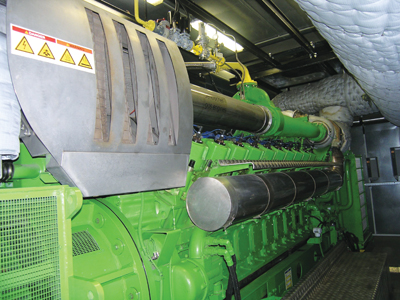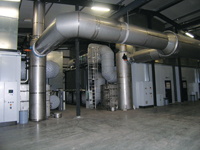
Features
Energy
Management
Special Series European trends #4: CHP maintenance contracts
November 23, 2010 By Paul Hovius
In the second article in this series (June 2010), we looked at the
feasibility of Combined Heat and Power (CHP) systems for horticulture.
In the second article in this series (June 2010), we looked at the feasibility of Combined Heat and Power (CHP) systems for horticulture. In addition to the capital investment, ongoing maintenance is an important consideration. These costs for a reciprocating gas engine are higher than those for gas turbines. The lifetime of a CHP unit is about 10 to 12 years, or about 60,000 operational hours. The cost for those 60,000 hours is more or less comparable with the original investment cost. The principles for the maintenance contract are usually included in the basic CHP sales contract. For some, the maintenance contract, received just before the commissioning, can be a shock.
 |
|
| Preventive maintenance schedules help ensure trouble-free operation of cogen systems. Advertisement
|
A reciprocating gas engine is a mechanical device that is subject to wear and tear. It’s comparable with a car that, at regular intervals, has to stop at the garage. The maintenance contract includes the repair of malfunctions and the planned maintenance work.
The motor supplier has defined maintenance work at regular intervals. The costs for materials and labour are included. The supply, and also the environmentally friendly removal of the used lubricating oil, is the responsibility of the motor supplier. In case the motor is equipped with an SCR, the motor supplier will substitute the blocks in the catalyst. Very important is the NOx value at which the catalyst will be replaced. Most maintenance contracts include an insurance provision for machinery breakdowns. This means that if the engine is broken, the cost of the necessary part (the parts not subject to wear and tear) will be reimbursed by the insurance company.
MAINTENANCE PLAN AND COST
■ The maintenance plan is a kind of matrix indicating the maintenance work in 2,000-hour intervals. At about 60,000 operating hours (a different value for different suppliers), the motor will need a factory overhaul. This work is normally not included in the maintenance cost per operating hour. The duration of the maintenance contract is usually 10 years, or 59,999 operating hours.
 |
|
| A multi-unit cogen system at a tomato greenhouse in the Netherlands. |
Maintenance requirements are limited through to about 10,000 operating hours. However, at about the halfway point to the 60,000-operating-hours level, there is a major overhaul of the engine. The grower, however, pays a fixed price per operating hour for the maintenance. This means the grower pays more than costs for the motor supplier for the first 30,000 operating hours. The motor supplier saves the money from the grower for the major overhaul.
To be honest, after the major overhaul of the motor, the motor supplier will be paid back by the grower in the remaining operating hours through to the end of the contract. Nowadays, the grower(s) often choose(s) to exclude the major overhaul at the halfway point in the maintenance contract to have lower costs per operating hour; however, the grower has to pay for the overhaul the moment this work is carried out.
The CHP supplier has included in his quotation the main issues as listed previously in the maintenance contract. Generally speaking, the maintenance contract will be signed just before the commercial operation starts. The suppliers have a standard maintenance contract and it is very difficult to make changes to the standard contract.
Looije Agro Technics has discussed maintenance contracts with several suppliers, resulting in a modified standard maintenance contract for growers buying a CHP system through us. The maintenance contract generally includes insurance for machinery breakdowns. This covers the cost of machinery parts from the supplier that break down during the contract period. It is important to realize that parts of the unit, for example the electrical parts, are not covered under the maintenance contract of the CHP supplier. The insurance for the machinery breakdown covers only the costs for replacing the broken parts, and not any costs associated with lost production.
BASIC MAINTENANCE CAN BE DONE BY THE GROWER
■ Basic maintenance will usually be done by the grower, with or without telephone assistance from the help desk of the motor supplier. Examples are filling the motor water, fixing couplings and sometimes replacing the spark plugs. Generally speaking, growers with a little technical background can carry out basic repair work. The advantage for the grower is that the failure has been repaired in a short time and he or she will not have to wait for the arrival of the maintenance engineer from the motor supplier.
The control cabinet of the CHP unit has been equipped with a modem. The help desk of the motor supplier can access this modem and review the status of the engine. The main parameters of the engine are shown on the screen. Nowadays, the information is transmitted over the Internet. It is also possible to have this information available on a climate computer. In case of a malfunctioning of the motor, the help desk will investigate the failure and solve the failure in co-operation with the grower, or it will send a maintenance engineer in case the failure cannot be solved by the grower.
In our opinion, it is important that growers are aware of the maintenance philosophy of the motor supplier, because with the purchase of the motor, the grower enters into a longtime relationship with the motor supplier.
Print this page